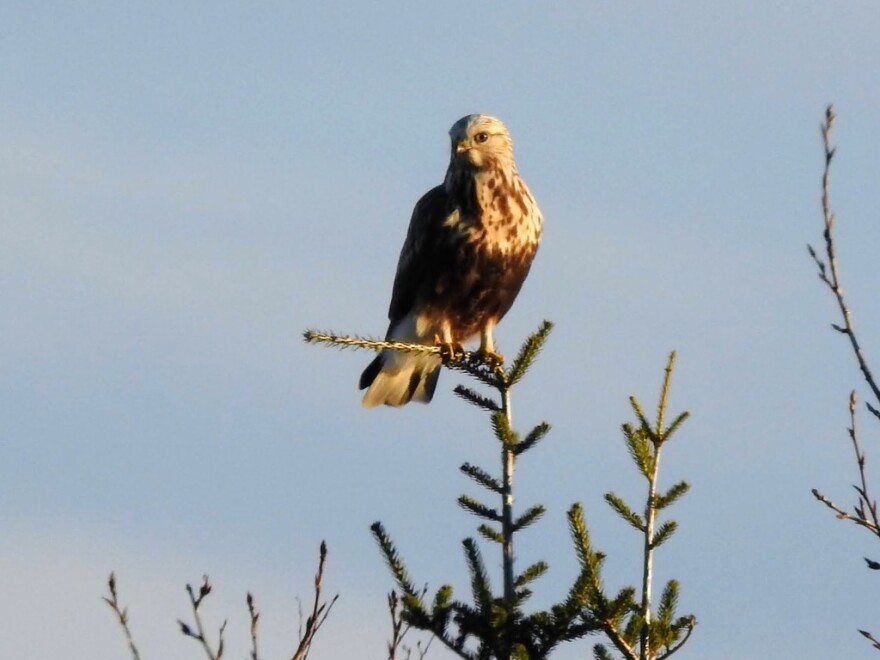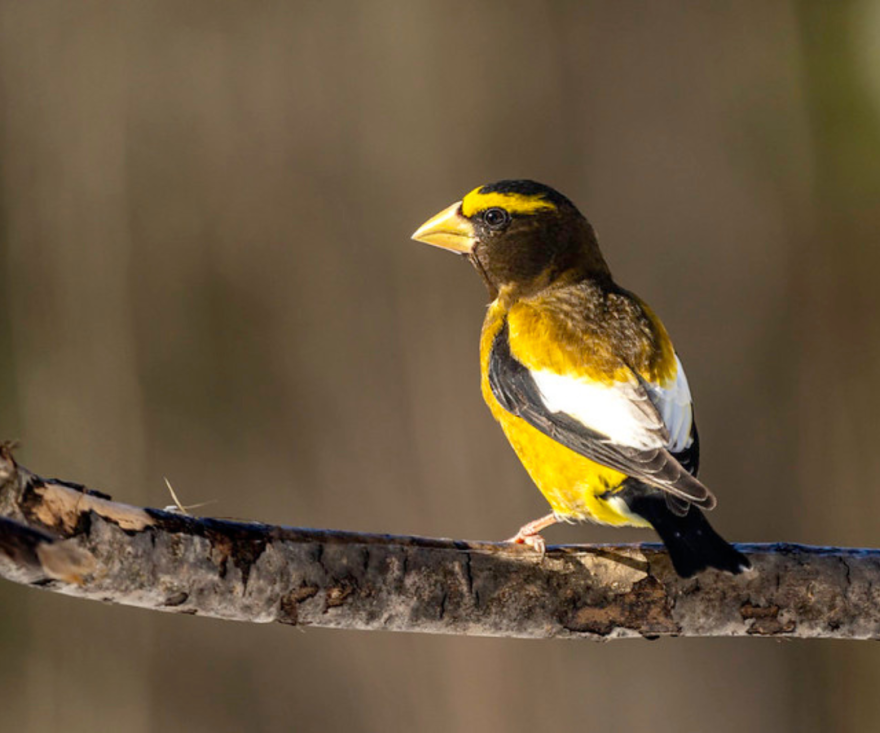A quiet time for backyard birds
November, Pam reflected, is a quiet time (in terms of observable species) for backyard bird feeders. The summer birds have left, and the winter birds haven’t quite moved in. However, there have been a few notable occurrences.
First, a Northern Shrike landed underneath one of Pam’s feeders in the Brainerd area. These magnificent songbirds are the only predatory songbird in Minnesota. Unlike birds of prey, which kill with their strong talons, Northern Shrikes have relatively small, weak feet (though they do have a sharp, hooked bill). They feed primarily on other birds.

Pam is still waiting for the winter finches to arrive. In the meantime, she is seeing woodpeckers, Northern Cardinals, a few American Goldfinches and the occasional Purple Finch. (Cardinals are more common in the southern half of the state, as well as along the shores of Lake Superior. They are only rarely seen in Northern Minnesota.)
In contrast, the American Goldfinches and Purple Finches have all already departed John’s observation areas in Grand Rapids.
To John’s consternation, even the Dark-eyed Juncos have left. John usually feeds them a whole bag of millet before they leave town, but they left while he still had a quarter-bag of seed for them.
Pam is also finding few juncos eating near her place. She hypothesizes that the mild weather would have kept them in the northern regions for longer, so maybe cold weather will bring a second wave of them through the area.
Rough-legged Hawks
To John and Pam, the prospect of which birds will be coming to town is more exciting than who’s already there. Pam is most excited to see Rough-legged Hawks.
“I think the Rough-legged Hawk is my favorite hawk in Minnesota, and that’s why I really wanted to talk about it. Because I think they are just really cool hawks,” she said.
They are only found in the state in spring and fall, since they breed in the high arctic tundra. They can be tricky to identify by plumage and field markings, since the males, females and juveniles all have different markings. To make it even more complicated, they also have two color morphs: light and dark.

However, Pam still finds them one of the easiest hawks to identify. Here are her tips to identify them, listed in approximate order of importance:
- Season: Not seen in summer. Most often seen between October and April, when most other hawks have departed the region (though Red-tailed Hawks may linger in central and southern Minnesota).
- Behavior: The only big hawk here in fall and winter that hovers over open fields. Often perches on power poles, power lines and the very top of trees (Red-tailed Hawks tend to perch lower down.)
- Habitat: Nearly exclusively found near open country.
- Size: Large hawks with long wings.
There are a few spots in Minnesota where Rough-legged Hawks are seasonally abundant, such as in Aitkin County and in wild rice beds south of Brainerd.
They are also found near Sax-Zim Bog. (While Pam and John weren’t quite sure of this, it was confirmed at the end of the segment by Betsy Crabb, the mayor of nearby Meadowlands and Green Cheese Trivia host.)

Who else is coming to town?
Other eagerly awaited winter residents are the Pine and Evening Grosbeaks, Pine Siskins and Common Redpolls. John has heard reports that the grosbeaks have been seen in the state but hasn’t seen them himself yet.
Pine and Evening Grosbeaks are somewhat reliable winter residents to Northern Minnesota. Pine Siskins and Common Redpolls, however, are more intermittent visitors.
Unfortunately for Pam, the vibrant Evening Grosbeaks typically don’t venture as far south as Brainerd. Instead, she drives up to Sax-Zim Bog to see them.
Sax-Zim Bog
Sax-Zim Bog is a biodiversity hot spot for birds, and a nationwide destination for birders. The large, visible population of Great Gray Owls is most people’s focus, but there are also grosbeaks, Boreal Chickadees and even Rough-legged Hawks to admire.
Even better, Sax-Zim Bog has a phenomenal group of naturalists who offer some great field trips. Hope to see you there!
Controversy among the bird nerds
To conclude, John and Pam discuss a controversy in the birding world: a recent decision by the American Ornithological Society to remove people’s names from the common names for birds (like Cooper’s Hawk, Swainson’s Hawk and Wilson’s Warbler). This decision was made for a variety of reasons, including cultural, scientific and educational.
Firstly, some of the human namesakes of these birds were slaveowners or participated in other unacceptable practices or beliefs. Replacing these names will, proponents suggest, make birding a more inclusive experience.

Secondly, ascribing one human’s name to an entire species negates the species’ own unique characteristics, history and importance, suggest proponents of the renaming initiative. The new common names aim to redirect focus to the bird itself, instead of a human.
Lastly, human names are useless for those learning how to identify birds. A name like “Yellow-rumped Warbler” or “Boreal Chickadee” tells a birder something about the bird: plumage and habitat, respectively. “Cooper’s Hawk” lacks that specificity.
John and Pam are less enthusiastic about the initiative, but willing to accept it.
“First of all, it’ll be a big mess, but we’ll get used to it ... I understand why they’re doing it,” Pam said. “ … I get that, but to me, a Cooper’s Hawk has been a Cooper’s Hawk for a long time!”
John responded, “Right? Unless you think back to when — now, was that the one known as the Pigeon Hawk? Or was that the Chicken Hawk?”
“It was one of those,” Pam responded.
“And if you look up, like, the Northern Flicker — I think it has 50 colloquial names that go along with it. So, you know, people are going to call them whatever they’re going to call them. But maybe 100 years from now, the names will become common and accepted,” John said.
Pam replied, “It’s just that I get used to certain names, and boy, that’s just what I stay with.”
“They do the same thing to plants all the time,” John added.
“I know, I know. And it’s just to confuse us older people,” Pam said.
“Us older guys and gals, yeah, it’s just to make our lives more difficult,” John agreed. “Pam, let’s make your life easier and let you go this morning. Thank you for joining us, it’s always a pleasure to chat with you. I look forward to our next conversation.”
A heartwarming beginning
Not all of their conversation was about birds. Pam mentioned the emotional and touching celebration of John’s anniversary with his program on KAXE.
Pam began, “So, John, I was listening last week to all the tributes, all the call-ins, all the stuff — your 40 years of Phenology — and I’m going, ‘Well, we can’t be done yet!’ I have to say a big thank you, because I have enjoyed getting to know you, I have learned so much from you, and you know — just, 40 years is just an amazing thing!”
John replied, “It’s been a long, strange trip. But I will honestly say, Pam, that you have probably taught me more than I ever could have hopefully taught you. Because you are one of those people I turn to when the questions turn to well, herpetology and birds. You are very familiar with both those subjects and you have helped me many, many times to answer listener questions to inform myself so I can do a better job on the radio. Thank you. Thank you.”
Pam responded, “Well, we learn from each other, right? And there’s so much to know about the outdoors. They’re constantly learning. I’m still learning.”
The pair chat about how Pam Perry started working with KAXE, and the importance of community radio. They also discussed their shared pride in former students Ben Stubbs and Sam Guida, both of whom were middle school students of Pam’s husband, Ken Perry. They were early contributors to John’s “Phenology Talkbacks” segment, which features kids’ nature observations from around the state.
“Last Tuesday, when I heard what was said from Ben Stubbs and Sam Guida — I've known those guys since they were in middle school, and I’ve watched them grow up and blossom ... I had tears running down my face,” Pam said. “So, you know, John, you’ve had an impact on a lot of people.
“You know, my job was working with the outdoors, the environment, getting people concerned about things and interested and outside. And you do the same thing.”
“That’s our aim,” John replied. “Our aim is to get people out of doors.”
Next time
We’re all looking forward to their next conversation — it's scheduled for mid-December. Tune in to the KAXE Morning Show to listen live, or you can find it here!
For more phenology, <b class="rte2-style-bold">subscribe</b> to our Season Watch Newsletter or visit the Season Watch Facebook page.
Funding for this project was provided by the Minnesota Environment and Natural Resources Trust Fund as recommended by the Legislative-Citizen Commission on Minnesota Resources (LCCMR).









